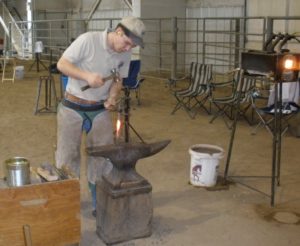Learning From Mistakes

Progress is only made when you practice, attend to the mistakes and practice again; repeating the process over and over again.
The best farriers want to excel in their craft. To do this, they are constantly on the lookout for skills they can improve. It is a lifelong pursuit. These farriers aren’t worried they don’t “know it all” yet. They are comfortable with the idea that they may never know it all. The never-ending learning is the fun part. Some farriers are more efficient at progressing in skill than others. There must be a method to learning in order to make any sort of advancement.
In Daniel Coyle’s excellent book, The Talent Code, he discusses the concept of “mistake-focused practice.” This is a foreign concept to some. Some people are so scared of making a mistake, that they avoid the practice that will inevitably bring about mistakes. There will never be any progress here. First, we must accept that mistakes are not only okay, but they are a key factor to our progress! Mistake-focused practice is done when a person tries something, attends to the mistakes, and then tries it again, attends to the mistakes again, and then tries over and over again until it is right. Coyle states in his book, “Struggle is not an option. It is a biological requirement.” So if you thought you could get away with learning this craft “the easy way,” think again!
Now that we know that we are supposed to be focused on mistakes, the next step is to identify them. We have worked with many farriers that are frustrated because they don’t know where they are going wrong. They know something is wrong, but they don’t know how to fix it because they don’t know where the mistake is originating. For this, Daniel Coyle suggests, “chunking” down your practice into the smallest possible units. For a farrier, this can be breaking down each step of the job into small chunks. For example, leveling the foot may be thought as one procedure or as several smaller procedures to make up the whole: 1) rasp from lateral heel to medial toe; 2) rasp from medial heel to lateral toe; 3) rasp from medial toe to lateral heel; 4) rasp from lateral toe to medial heel. By having the steps broken down or chunked up and doing it the same every time, it is easier to identify where a mistake occurs. Then it can be fixed!
The most beneficial way to start learning something new is to absorb the whole process first. This means to work with a skilled craftsman (someone who is better than you!). Watch someone who has paid a price of lifelong practice. Pay attention to how they hold the tools, how they stand under the horse, how they move from the fire to the anvil. Absorb how it is supposed to be done. If you’re lucky, you’ll have a teacher that can explain what they are doing as they do it. Next, when it is your turn to put it into practice, break it into chunks so that you will be able to see where you make mistakes when they inevitably come. Finally, slow it down. The master will make it look easy. It will look flawless and smooth and quick. The temptation for the beginner is to try and mimic what the master is doing right away. Robert Bjork said, “Effortless performance…is really a terrible way to learn.” It is better to chunk up the process in your mind and slow it down so that you do it right. The speed will come in time!
Because we are focused on small chunks of the job, mistakes become evident and we can work on them. Ideally, we practice so much that the mistakes become less or go away entirely. Now we can focus on other mistakes in other parts of the job. There is always something to learn! Coyle says that the trick to continually learning is “choosing a goal just beyond our present abilities; to target the struggle. Thrashing blindly doesn’t help. Reaching does.”
If you’re a practicing farrier now that has reached a plateau but would like to improve some part of your business, this is a great reminder of how to do it. “Chunk up” or break down the parts of the job to identify what you want to improve, choose a goal just beyond your present ability and do the mistake-focused practice needed to improve.
Related Posts
-
Foal limb soundness begins before a foal is born. It involve...May 18, 2010 / 2 comments
-
©2013 Doug Butler PhD, CJF, FWCF Butler Professional Farri...May 14, 2013 / 0 comments
-
In recent years, there have been more and more women enterin...Feb 01, 2018 / 0 comments
Blog Categories
- Anatomy
- Best Business Practices
- Conformation
- Current Events
- Customer Service
- Draft Horse Shoeing
- Equine Soundness
- Essential Anatomy Kit
- Farrier Careers
- Farrier training
- Foal soundness
- Horse Care
- Horse Foot Care
- Horse Owner Tips
- Horsemanship
- Horseshoeing
- Horseshoeing History
- Iron and Forge Work
- Student Spotlight
- Uncategorized
- Veterinary Care
Blog Archives
Contact Us
Butler Professional Horseshoeing School
495 Table Road
Crawford, NE 69339
(800) 728-3826
jacob@dougbutler.com
Subscribe to Our Blog
Get Our Free e-Book!
If you think you want to become a farrier (or know someone who does), this book can help you make that decision. Horse owners will learn the importance of choosing a qualified farrier and how to select the “right” one.
[ Get the e-Book Now! ]
- Follow:
